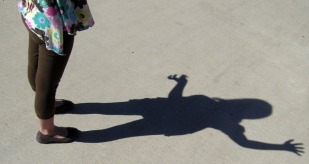Global Shadow Tracking
Introduction
This lesson was developed as part of a requirement for EDTEC 570, Advanced Teaching with Technology, at San Diego State University. It incorporates a lesson from a FOSS (Full Option Science System) unit called Sun, Moon, and Stars.
In the FOSS unit's "Shadow Tracking" investigation, students explore shadows and relate the change in their shadow's position to the change in the Sun's position in the sky.
In "Global Shadow Tracking" students share the data from this investigation with other students around the world. The telecollaboration happens when students share data from partner schools at different latitudes, including some in the opposite (northern or southern) hemisphere. Measuring their shadows one morning a month over the course of the year will give them data to compare to what is happening in other places on Earth.
In the FOSS unit's "Shadow Tracking" investigation, students explore shadows and relate the change in their shadow's position to the change in the Sun's position in the sky.
In "Global Shadow Tracking" students share the data from this investigation with other students around the world. The telecollaboration happens when students share data from partner schools at different latitudes, including some in the opposite (northern or southern) hemisphere. Measuring their shadows one morning a month over the course of the year will give them data to compare to what is happening in other places on Earth.
Last updated on July 1, 2009. Based on a template from EDTEC 570 at SDSU
© Christina Lahr, Diane Main, and Karen McKelvey
A Telecollaboration Lesson for Grade 3 and up (Science with Math, Social Studies, and Writing components)
Designed by Christina Lahr, Diane Main, and Karen McKelvey
In the FOSS "Shadow Tracking" investigation students will:
- Determine the Sun rises in the east and sets in the west.
- Observe and record the path the Sun takes in the sky.
- Observe that the Sun changes position in the sky from season to season.
- Observe that shadows are the areas of darkness created when an solid object blocks light.
- Observe and collect shadow data created when sunlight is blocked by their bodies.
- Analyze shadow data to develop a logical conclusion and explain that the Sun moves across the sky during the day.
- Use shadow data to predict the position of the Sun in the sky.
- Observe that shadows on Earth depend on the position of the Sun in the sky.
- Understand that seasons affect the exact path the Sun takes in the sky.
